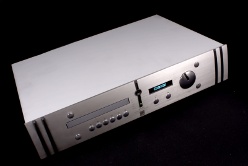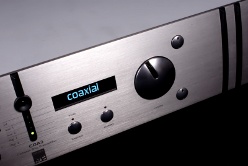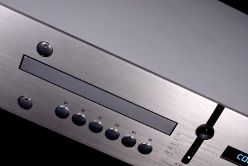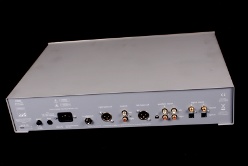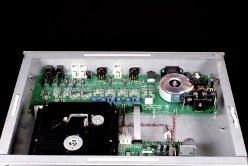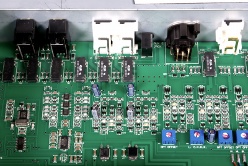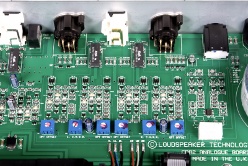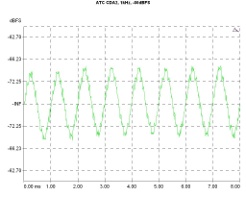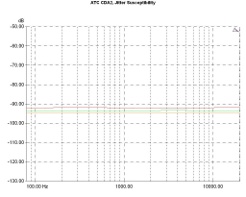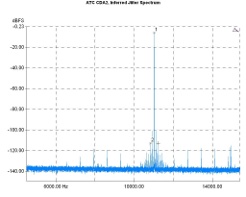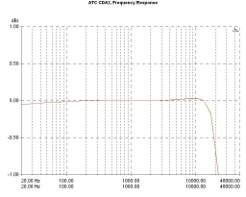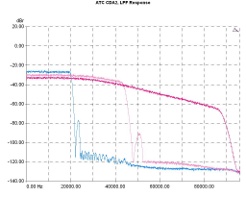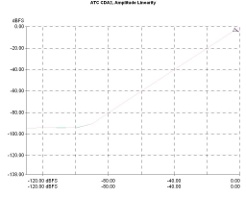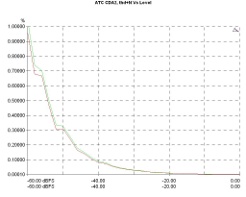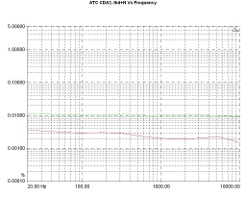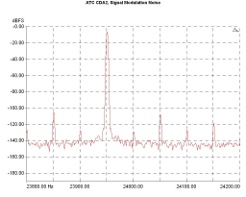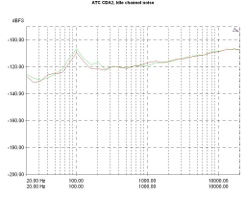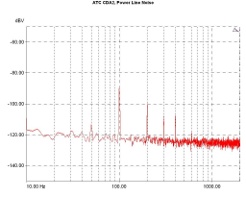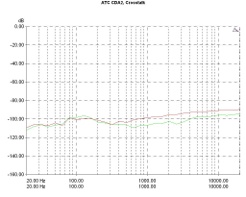Interesting Stories about Audio & Home Entertainment technologies
Last update: Jun. 26, 2012
CD PLAYER/DAC/PREAMPLIFIER
ATC CDA2
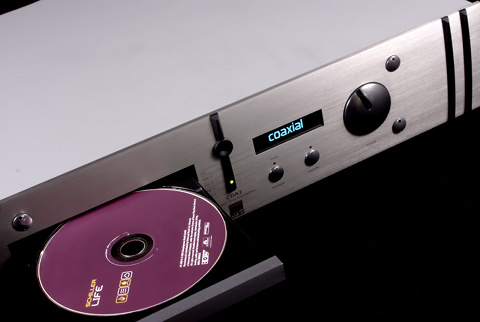
While it feels some kind of strange to integrate a digital source with a preamplifier -this is not an architecture frequently met- there are no reasons why this wouldn't consist a good idea after all. Digital signal processing requires only small real estate on printed circuit boards with the designer, normally trying hard to short any bus lengths while the d/a converter architecture used in most CD players essentially includes all needed to offer some digital connectivity. Add to above a line level preamplifier that could be the physical extension of any digital source with some add-ons like an input selector and a level control and what you have is a full featured front end that could serve as the basis of a minimalistic system, provided you can add a power amplifier and some speakers. The fact that the CDA2 offers a pair of balanced outputs with good common mode rejection ratio (a spec that is even mentioned rarely in balanced mode audiophile connections anymore) obviously points out what ATC has in mind as the better solution: A pair of monoblock amplifiers positioned near the loudspeakers at least, or -ideally- a pair of active loudspeakers.
CDA2 appears to be based on ATC's preamplifier CA2, both as to aesthetics and circuitry. There is a 13mm aluminum facade chassis offering a sense of good quality. The layout is clean and straightforward to use, with the transport controls placed on the left, underneath the disc tray (this means that you should push the tray in, or use the remote control, though), the input selector and a high contrast screen placed on the center, the volume control knob being on the right.
Digital connections are offered through two groups of S/PDIF inputs, each one consisting of a coaxial and a Toslink connector. The user can also choose from two analogue, line level, inputs. One of these inputs can be used through a front panel placed 3.5mm mini jack as well, a useful provision for anyone uses a personal media player in a regular basis. As already mentioned, there is a balanced output and a single ended pair of RCAs as well, with the former offering two times the output level of the later and a CMRR of 60dB (a good measure of how well any noise and interference induced from the environment is suppressed). According to ATC's specs, the balanced output is capable of driving 100Ω loads. There is also a headphone output (uncomfortably placed in the rear panel) and a fully functioning remote control. What is missing, is a USB port for the DAC to be connected to a computer. This is something that ATC should definitely add in the near future, given the hard competition in this area and the rapidly raising proportion of users searching this kind of feature.
Details
ATC approached the design of CDA2 with a rationalistic mood, as it appears to offer a balance between good build quality and the need to use more affordable than eccentric solutions. The optical drive is sourced from Asatech and offers swift and low noise operation while the digital processing part is based on Wolfson chips (the WM8804 interface and the WM8740 converter). Since the 8740 chips incorporate the i/v converters, the analog part of the DAC consists of a circuit with three opamps per channel, probably in the classic configuration needed to convert the balanced dac output to a single ended line, before its routing to the preamplifier part.
As already mentioned, this part of CDA2 is based upon ATC's preamplifier, the CA2. It appears that there are two discrete component amp stages with an Alps potentiometer placed between them. Each output stage consists of two parts to drive the balanced output. Power is sourced through separately regulated power supplies, the signal routing is realized through on-board micro switches and there are fine tuning trimmers near the output stages, a detail that drives to the conclusion that every unit is separately adjusted for the best possible performance.
Lab Results
The CD player part of the CDA2 proved to be quite capable of revealing low level information. Playback of a -80dBFS tone resulted in a very good waveform with just a small amount of high frequency noise and a very low level of noise that could be attributed to low frequency sources like the power supply. Wolfson's solution for the digital interface proved to be quite good. Jitter susceptibility appears to be low, with the corresponding distortion curves lying below the -90dB line in the diagram and without any significant change as the jitter frequency rises. This could be a good indication that the CDA2 offers low sensitivity to jittery transports and/or less than ideal digital connections.
Inferred jitter was about 43pS (500Hz), 260pS (200Hz) and 1nS (100Hz). Based on these values, one concludes that jitter rejection starts at low frequencies (Wolfson states 100Ηz for their digital interface) and that even the worst case of 1nS is about 8 times lower than what the digital interface standard mandates (0.05UIs). Frequency response appears to be flat for any practical purpose with very small differences between the two channels.
The low pass filter behaves as expected with the slope getting more relaxed as the sample rate rises. Linearity was also quite good and the output seems to follow a straight line rule down to -90dBFS. In general, both the distortion and the noise in the output are quite low even at -60dBFS where the relevant figure was 1%. THD was about 0.01% for a level of -20dBFS and between 0.002% and 0.003% for a level of-1dBFS. This behavior is a good indication that the output stage is nowhere near its overload point even when the d/a converter approaches its theoretical maximum output. The signal modulation noise graph contains some clear intermodulation artifacts, at 50/100Hz multiples from the fundamental that could be attributed to the power supply. These artifacts are quite low in level, under -100dBFS. There is, also some intermodulation from very low frequency interference as the skirt around the fundamental shows (but well below -120dBFS).
The noise behavior of the CDA2 (measured with a digital signal) was very good. Static measurements indicated -98.6dBFS (CCIR) for the idle channel, -102.5dBFS (CCIR) as signal to noise ratio and -108.6dBFS (CCIR) for any power supply interference. These are pictured in the relevant graphs where the idle channel noise shows a typical uprising trend towards high frequencies (-105dBFS at 20kHz) and the power line noise spectrum includes a strong 100Ηz peak (about -90dBV) and a quite weaker one at 50Hz, along with some intermodulation products of these. Note that although these components could be clearly observed visually, their levels (given in dBVs) are quite low, suggesting a good power supply design. A quite interesting figure is the crosstalk. This is below -90dB for both channels (a figure that confirms the ATC spec although it appears there is a difference between the two channels) and puts an end to the discussion about how good is the idea of offering a combo like this. Obviously, with a good pcb design and sensible signal routing there are no crosstalk problems.
The preamplifier part of the CDA2 (measured through its single ended input and output) proved to be both sensitive, needed about 300mVrms for 1Vrms output, and with a more than adequate headroom since clipping was observed at about 9.7Vrms (with an input of about 3Vrms). Mind, that when using the balanced output this figure is doubled. Static distortion measurements were in low levels in general, with thd+N at 0.003% and imd/smpte at 0.0005% (both measured at 1Vrms output level) while noise was about -80.3dBr(A) (with a 0.1Vrms reference, which is quite low). Crosstalk in the analog domain remained at about -90dB (at 10kHz). The attenuator tracking was good above its middle position (with a maximum deviation between the channels at 0.08dB) but less so at high attenuation levels, where the worst case channel balance was about 0.48dB. 1kHz output and noise spectra were as expected to be (given the measurements through the digital inputs) the former including some harmonics (with the second being the highest in level, at -105dBr and the series being clearly decreasing with increasing frequency) and the later showing essentially the same picture but with different reference (hence the different levels, here). Finally, thd+N Vs frequency was measured between 0.002% and 0.003% (for 1Vrms output) with some slight differences between the two channels. The distortion remains constant with level between 0.8Vrms-8Vrms, the later being the point where the overload region seems to start. At 9.7Vrms the distortion figure is about 3% confirming the static overload measurement.
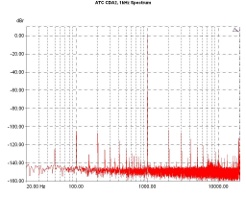 |
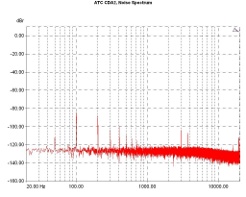 |
Output spectrum for 1kHz input (line in). 0dBr: 1Vrms |
Output noise spectrum. 0dBr: 0.1Vrms/1kHz |
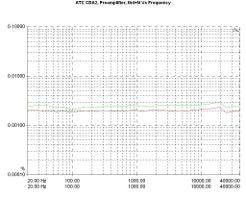 |
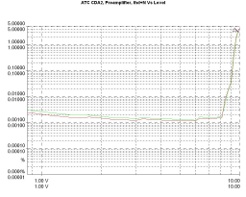 |
thd+N Vs Frequency, Line In. |
thd+N Vs Level, Line In. |
Listening
CDA2 proved to be a very good performer indeed, offering a balanced and neutral result without hints of a character or a significant sound coloration. There is enough detail and dynamics to construct a convincing sound stage, while at the same time the listener enjoys a feeling of easy listening, even in quite high sound levels. The low crosstalk figure, the good channel balance (at least in the upper half part of the attenuator) and the small differences between the two channels in general, obviously paid off. Given a decent pair of loudspeakers and just a conventional listening environment, stereo imaging will be extremely good, with well focused sound sources (when appropriate) and a rich sound field.
The low frequency part of the spectrum was quite extended, well controlled, offering good feeling of the rhythm section. Listening was full of detail towards the very lows, always a good attribute the value of which will be appreciated when listening to electronic music or contemporary soundtracks, nearly always heavy loaded with extremely low frequencies.
Midrange offered a sense of fullness, and they were transparent and detailed. The listener had always a feeling of being near the orchestra and the voices, both the solos and the choir, were rich and quite realistic both in size and character.
The high frequency part of the spectrum offered a sense of good extension and transparency and the whole result was that of richness while at the same time there were no tracks of harshness. This could be the typical character of a good upsampled system based on CD resolution but CDA2 was also very good through its digital inputs with high resolution data (through an M2Tech HiFace Two interface). Using 24/96 tracks the listener could appreciate more of the neutrality and the details offered from ATC's combo. Trying the Teac Esoteric P70 transport through a coaxial input (with the P70's on board upsampler adjusted to 2x), one can conclude that the Asatech drive is good enough for the price tag but, obviously, there is a headroom for better performance from the digital part. This is because the result with the P70 was even more detailed and transparent. Therefore, CDA2 seems to offer a good path for upgrade the system, adding -when needed- a better digital source or a source able to process program of higher resolution.
How good was the CDA2 as a conventional, analog preamplifier? The answer to this question is “quite good” given the price asked. Apart from the rather small number of inputs (if you own a rack full of sources you will have a problem connecting them all) and the lack of a loop (for the case you want to add an external processor), CDA2's preamplifier section proved to be transparent, with low noise levels and therefore capable of quite good dynamics. Stereo imaging was at the same level as when listened through its digital part and the feelings of easy listening, the fullness and the realism were also there. The final result is that this is not a casual preamplifier stage, included only to justify the integrated form of CDA2, but a well designed, full spec preamplifier. Finally, the (separate) headphone amplifier proved to be good enough for some serious listening through a Grado RS2 set. The result was of good control in the low frequency region, enough driving capacity and a very detailed yet easy to listened to overall result.
Conclusion
As uncommon as it is, CDA2 appears to be a well designed and interesting product. Incorporating a digital source, a DAC and a line level preamplifier in a single chassis, ATC offers a complete front end to anyone with a power amplifier and a loudspeaker already in place and a great basis for a minimal yet quite versatile system. Build and sound quality are very good and the price is more than tempting. In the end, this is a piece of equipment of great value for money.
Equipment used during listening sessions
Teac Esoteric P70/D70, Nirvana DC-110, dCS Puccini U-Clock, Melos Plus Series Line, Copland DRC-205, Parasound HCA3500, ATC SCM-50PSL
LISTENING SESSIONS
The following recordings were made with a DV-RA1000 Tascam master recorder (using 24bit/192kHz sample rate) and you can download them to have an impression of what the device under review sounded like. It is obvious that any recording of this kind could not be absolutely transparent but, according to our experience, the majority of sound attributes we listen to, during the actual listening sessions, are preserved. The file format is .wav, so expect that the zipped files will be quite large (even if the clips are about a minute or less long. You could use a ABX listening plug-in like the ABX plug-in for foobar2000 if you want to make some more elaborate experiments. Contact is if you have any questions.
TRACK LIST:
ATC CDA2
| Specifications (Data according to the manufacturer | |
|---|---|
| Description: | CD player, DAC, Preamplifier |
| Disc compatibility: | CD, CD-R/RW |
| Digital Inputs: | 2x pair of S/PDIF coaxial (RCA)/optical (Toslink) |
| Analog Inputs: | 1x single ended (RCA), 1x single ended (RCA/mini jack 3.5mm) |
| Analog Outputs: | 1x single ended (RCA), 1x balanced (XLR), 1x Headphones (jack 1/4inch) |
| Sample rates: | 44.1-192kHz, 16/24bit |
| Frequency response: | 2Hz-280kHz |
| Output impedance: | 10Ω |
| Common Mode Rejection Ratio (CMRR): | 60dB (balanced outputs) |
| Other Features: | Remote control |
| Dimensions: | 445x90x330 (mm, wxhxd) |
| Weight: | 7kg |
| Price & More Info | |
|---|---|
| ATC CDA2: | €2.200,- (list price, for the greek market) |
| More Information: | web: http://www.atc.gb.net/ |
| Review Sample | Location Sound |

